Book contents
- Frontmatter
- Contents
- Abbreviations
- List of maps
- List of figures
- List of tables
- Notes on contributors
- Map
- Preface
- Introduction
- PART I
- PART II
- Further reading
- Chronology
- Index
- Frontmatter
- Contents
- Abbreviations
- List of maps
- List of figures
- List of tables
- Notes on contributors
- Map
- Preface
- Introduction
- PART I
- PART II
- 9 Religion
- 10 Culture and media
- 11 Science and medicine
- 12 Society and welfare
- 13 Gender and sexuality
- 14 Indigenous Australia
- 15 Class
- 16 The economy
- 17 Government, law and citizenship
- 18 Education
- 19 The environment
- 20 Travel and connections
- 21 Security
- 22 Australia, Britain and the British Commonwealth
- 23 Australia in the Asia-Pacfic region
- 24 The history anxiety
- Further reading
- Chronology
- Index
24 - The history anxiety
from PART II
Published online by Cambridge University Press: 05 November 2013
- Frontmatter
- Contents
- Abbreviations
- List of maps
- List of figures
- List of tables
- Notes on contributors
- Map
- Preface
- Introduction
- PART I
- PART II
- Further reading
- Chronology
- Index
- Frontmatter
- Contents
- Abbreviations
- List of maps
- List of figures
- List of tables
- Notes on contributors
- Map
- Preface
- Introduction
- PART I
- PART II
- 9 Religion
- 10 Culture and media
- 11 Science and medicine
- 12 Society and welfare
- 13 Gender and sexuality
- 14 Indigenous Australia
- 15 Class
- 16 The economy
- 17 Government, law and citizenship
- 18 Education
- 19 The environment
- 20 Travel and connections
- 21 Security
- 22 Australia, Britain and the British Commonwealth
- 23 Australia in the Asia-Pacfic region
- 24 The history anxiety
- Further reading
- Chronology
- Index
Summary
Australia has no history to speak of, or let us say, sing of.
Adelaide Advertiser, 1 February 1907‘Tarraganda’ (an Indigenous word meaning chain of ponds) is a rich, well-watered stretch of country close to the town of Bega on the far south coast of New South Wales. A narrow strip of bitumen cuts its way from Bega through the surrounding pastureland and small farms, eventually turning to dirt as it winds over forested hills to the Pacific Ocean, barely 14 kilometres away.
When British settlers first set eyes on the area in the 1830s they immediately saw its potential for grazing. As was so often the case, they desired the same tracts of land that Aboriginal people prized, for the land was fertile and, due to regular Aboriginal firing, already partly cleared. The Imlay brothers – Peter, George and Alexander – Scottish squatter-barons with an insatiable eye for acquiring vast tracts of crown land, saw Tarraganda as one link in their pastoral empire on the far south coast and beyond. The homestead built in the late 1830s by the former Scottish surgeon, Dr George Imlay, was the first European structure to stand in the area. Eager to commemorate the occasion as one of historical significance, Imlay planted cuttings from a weeping willow (salix alba caerulea or ‘cricket bat willow’) that he had nurtured on the long voyage out to Australia. The cuttings were particularly dear to him because he had collected them during a short stay in St Helena, the isolated island in the South Atlantic Ocean where Napoleon Bonaparte was exiled in 1815 and died in 1821. Imlay, a devotee of French language and culture, took the cuttings from the willows that grew close to Napoleon's grave. His plantings at Tarraganda were the first weeping willows in Australia, and from this stock willows were planted later throughout New South Wales and the Australian Capital Territory, including along the Molonglo River near present-day Canberra.
- Type
- Chapter
- Information
- The Cambridge History of Australia , pp. 561 - 580Publisher: Cambridge University PressPrint publication year: 2013
- 5
- Cited by



